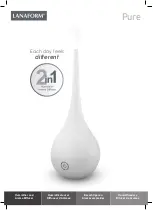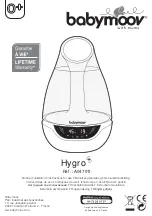
2
INSTALLATION REQUIREMENTS
These instructions are intended as a general guide only for use by
qualified persons and do not supersede any national or local
codes in any way. Compliance with all local, state or national
codes pertaining to this type of equipment should be determined
prior to installation.
Read this entire instruction manual as well as instructions
supplied with separate equipment before starting the installation.
The installation of the whole house dehumidifier must conform to
the requirements of the National Fire Protection Association, the
National Electrical Code, ANSI/NFPA No. 70 (latest edition) in the
United States, and any state laws, local ordinances (including
plumbing or wastewater codes). Local authorities having
jurisdiction should be consulted before installation is made. Such
applicable regulations or requirements take precedence over the
general instructions in this manual.
Install the conditioned air plenum, ducts and air filters (not
provided) in accordance with NFPA 90B Standard for the
Installation of Warm Air Heating and Air-Conditioning Systems
(latest edition).
The whole house dehumidifier is designed and approved for
indoor use only.
It is recommended that the whole house dehumidifier be
matched to the HVAC system to ensure proper operation and
efficient performance.
Refer to the rating plates located on the whole house
dehumidifier and on the HVAC system.
It is recommended that the whole house dehumidifier be
connected to only one existing HVAC system. If there are multiple
HVAC systems in the building, use one dehumidifier per system.
Tools and Parts
Gather the required tools and parts before starting installation.
Read and follow the instructions provided with any tools listed
here.
Tools Needed
Parts Supplied
■
Grommet plugs (4)
Parts Needed
Check local codes and HVAC supplier. Check existing electrical
supply, and read “Electrical Requirements” and “Location
Requirements” before purchasing parts.
Location Requirements
■
The dehumidifier may be installed on all new or existing
furnaces or air handlers used in residential applications.
■
The whole house dehumidifier is designed to be located
indoors.
■
Locate the whole house dehumidifier as close to the return air
duct of an existing furnace or air handler as possible to
minimize the required ductwork for connecting the
dehumidifier to the existing furnace or air handler.
■
The location should allow for access to the filter access panel
at the front of the dehumidifier for inspection and replacing
the filter. See the Minimum Clearance Requirements chart.
■
The location must allow for access to the electrical access
panel for servicing and maintenance.
■
Locate the whole house dehumidifier in an area where the
temperature is between 40ºF (4ºC) and 125ºF (52ºC). If the
dehumidifier is located in an area of extreme heat or high
humidity, additional external insulation may be required to
prevent condensation on the exterior of the dehumidifier.
■
If the dehumidifier is located above a living area or above an
area where water leakage may cause damage (see local
codes for other requirements), a secondary drain pan must
be installed under the dehumidifier.
■
The controls for the whole house dehumidifier are remote
from the dehumidifier and must be located in the space that
is to be conditioned. The controls are low voltage (24-volt)
and should be connected to the dehumidifier with code
approved, low voltage thermostat cable.
■
If the dehumidifier is located directly on structural building
members, use vibration absorbers/eliminators.
■
Locking pliers
■
Drill and drill bit
■
Screwdriver
■
Tin snips
■
Sheet metal screws
or rivets
■
Shop-fabricated sheet
metal turning vanes,
offsets, and transitions,
if needed
■
Sealant
■
Insulated flexible duct
■
³⁄₈
"-
16
all-thread rod for
suspended applications
■
Insulated duct for fresh air
ventilation
Minimum Clearance Requirements
For Optimum Service Access
Front
24"
Rear
12"
Blower End
12"
Top
12"


































